In all nations, young people must be prepared to make a meaningful contribution towards achieving sustainable economic and social development. Young people who enter the labour force equipped with appropriate skills can refresh and improve the quality of their country’s human capital. In other words, young people are perhaps the most critical determinant of long-term growth and development. For the purpose of this profile, the youth demographic is defined as the age group between 15-24 years. According to the Population and Housing Census conducted in Viet Nam in 2009, youth comprise the largest age group, accounting for 19.4 per cent of the total population of 85.79 million. They not only form the basis for demographic change but represent the future potential of the country.
This booklet is the eighth in a series published by the United Nations Population Fund (UNFPA) during recent years. Information is drawn from the Viet Nam 2009 Population and Housing Census data and from the Major Findings, a series of census data monographs developed by the General Statistics Office (GSO) and the UNFPA. The Population and Housing Census, conducted every 10 years, provides a comprehensive survey that identifies crucial information on national and sub-national population structure, educational attainment, employment, migration, housing status, and living conditions. The aim of this booklet is to analyse the Census data and create a profile of indicators highlighting trends among the young population as the generation most vital to Viet Nam’s future development.



